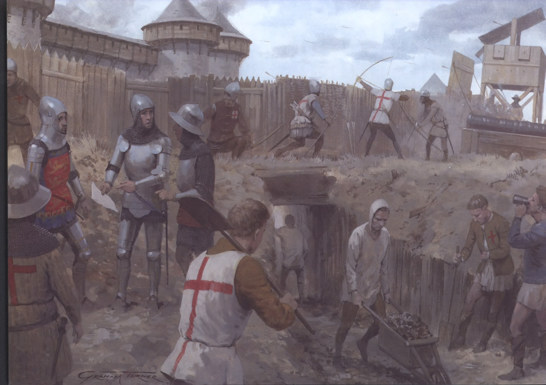Henry V: The Background, Strategies, Tactics and Battlefield Experiences of the Greatest Commanders of History Paperback (8 page)
Authors: Marcus Cowper
Tags: #Military History - Medieval

And after orders had been given for a blockade on the sea-ward side by the
fleet and on the side of the valley and the fresh-water river by small boats
(which would also serve, if necessary, as a means of communication between
the king and the duke and their divisions of the army), our king, who sought
not war but peace, in order to arm with the shield of innocence the just cause
of the great enterprise on which he had embarked, offered in accordance with
the twentieth chapter of Deuteronomic law, peace to the besieged if, freely and
without coercion, they would open their gates to him and, as was their duty,
restore that town, which was a noble and hereditary portion of his crown of
England and of his Duchy of Normandy.
Little remains of the
medieval fortifications of
The reference to Deuteronomy is significant as the relevant chapter authorized Harfleur, and the town is Henry to sack the city in the event of it refusing to surrender, putting all the now an industrial suburb male inhabitants to the sword and carrying off the women, children and all of the much larger port property as booty. The French commanders summarily rejected this demand of Le Havre. However,
and the two sides settled into the traditional pattern of a medieval siege.
medieval houses from the
A detailed chronology of the siege is difficult to establish from the various time of the siege do still sources, but it is clear that Henry was to a large extent relying on the power of remain, as does the parish his artillery train to overpower the walls and the defenders, enabling him to church of Saint-Martin, break into the town hopefully before too much destruction had been done, which dates from
as it was his intention to garrison and fortify the port to act as another the 15th century.
Calais - an armed camp projecting into his Duchy of Normandy. To that end (Author's collection)
he cleared the suburbs of Harfleur outside the
walls and moved his artillery pieces as close as
possible through the use of trenches, saps and
wooden hoardings to protect his gunners from
French crossbow and counter-battery fire. When
the artillery was not firing at night, the French
defenders sought to repair the damage to their
fortifications through the use of any material to
hand. At the same time as his artillery was trying
to break down the walls, Henry also sought to
undermine them by digging tunnels underneath
them that would then be collapsed, causing
sections of the walls to collapse also. Although
Henry made attempts against the Leure Gate, the
one opposite his encampment, the moat in front
of the wall ensured that this was a difficult task
and the area in front of the Duke of Clarence's
camp was judged more suitable, as the
Gesta Vita
Henrici
describes:
And while these activities were in progress, the
king decided to attack by means of mines and,
after a 'sow' had been made ready, to undermine
with passages below ground the walls on the Duke
21


of Clarence's side. But this operation (which, contrary to the teaching of Master
Giles, was begun in full view of the enemy since it could not be accomplished
in any other way at any other point on account of the nearness of the hill
and for other reasons), having twice been foiled by hard work of the enemy,
who used counter-mines and other technical skills in opposition to ours, and
recommenced yet a third time, brought no advantage at all.
The French were resisting much harder than Henry had anticipated. In a
letter dated 3 September to the citizens of Bordeaux, one of the senior clerks
of his household stated that the town would be in his hands within eight
days and that the king would then proceed to Dieppe, Rouen and Paris. Both
these claims would prove to be false as the siege dragged on into its third
week, with the French countering all English attempts to break through their
fortifications. September also saw a new threat develop in the English camp
as disease spread throughout the army - it was the 'bloody flux': dysentery.
The presence of such a large number of troops in such a confined area,
with all the effluent and other waste products that entailed, combined with
the damp, low-lying nature of the ground and the hot, humid weather,
proved to be a perfect breeding ground for the disease and it spread rapidly
throughout the army, affecting even the highest of nobles and courtiers.
On 10 September Richard Courtenay, Bishop of Norwich, contracted the
disease and by the 15th he was dead, with Henry V himself attending him
on his deathbed. On the 18th Michael de la Pole, Earl of Suffolk, died with
his title going to his eldest son, also named Michael, who was serving in his
father's retinue. By this stage the siege had also moved on to a new stage as,
on the 15th, a French sally from the Leure Gate caught the defenders off
guard, as the
Gesta Vita Henrici
relates:
And on the same day there occurred another event which was sufficiently
serious to cause the king disquiet; for our adversaries who were on guard at the
strongest barbican made a sally against our guard facing them and, because
The siege of Harfleur
Set in the siege lines attacking the Leure Gate that lies in the background, the bastion
in front of the gate is out of sight, hidden by the English palisade. At the centre is the
entrance to an English earthwork, with a sapper struggling out with a barrow of earth
and another making his way into the siege works. At left Sir John Holland discusses the
progress of the siege with one of his engineer captains. Along with Sir John Cornwall
and Sir William Porter, Sir John Holland was responsible for this sector of the English
siege works and was surprised by a sudden attack on the fortifications on 15 September.
This attack was revenged the following day when Sir John Holland launched an attack
on the barbican in front of the Leure Garte, setting fire to it and forcing the French to
retreat - an act that precipitated the final surrender of the town. To the right, two of
the labourers appear to be suffering from the dysentery that was to cut a huge swathe
through Henry's fighting forces.
22




of the inattention and indolence of our men, set fire to their defences.
But eventually, by God's will, the fire was extinguished and the enemy put to
flight without our men being seriously hurt. The enemy, however, taunted us
with being only half-awake and lazy, in that when on watch we had not been
able to keep a better look-out.
This assault provoked an immediate response and, the following day, Sir
John Holland, who was one of the commanders of the men facing the Leure
Gate and whose command had been attacked the previous day, sought to
make amends by launching an attack on the bastion or bulwark that
protected the Leure Gate. This attack, unlike the many that preceded it,
proved successful and the French defenders were burnt out of their position
and driven back behind the main walls. Following up on this success, Henry
entered negotiations with the French defenders once more, offering them
terms for surrender. Raoul de Gaucourt refused once again and Henry
planned an all-out assault on the town for the following day; by this stage
the townspeople had had enough and sent a message to Thomas, Duke of
Clarence, that they were wiling to come to terms. Realizing that their
position was now untenable, de Gaucourt and d'Estouteville now accepted
that should neither the King or the Dauphin come into sight by
22 September with a relieving army then they would surrender Harfleur
to Henry. A messenger was sent from Harfleur to Vernon, where a French